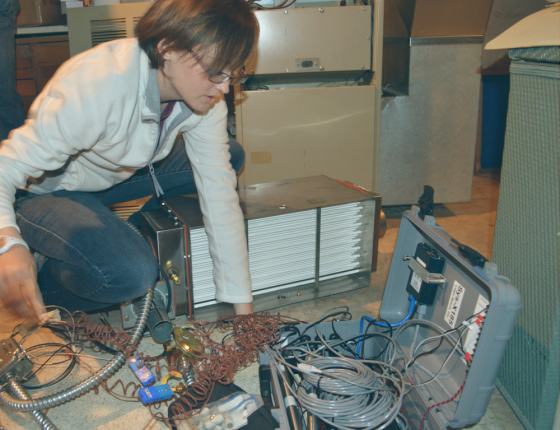Overview
The study investigated an alternative to furnace replacement in an effort to achieve high-efficiency space heating — an upgrade to residential standard efficiency furnaces called the transport membrane humidifier (TMH). Space heating is the number one end use for energy in Minnesota buildings, and residential forced air furnaces consume more energy for space heating than any other type of heating device. To date, the only way to increase the efficiency of a natural gas forced air heating system has been to replace it with a higher efficiency (90%+) model. The TMH saves energy by increasing the efficiency of induced draft furnaces from 76%-82% to the 90%+ efficiency level typically associated with condensing furnaces.
Methodology
TMH devices were installed and instrumented in four sites. Performance was continuously monitored to facilitate a comparison between baseline furnace operation and TMH operation. During bypass (baseline) mode, flue gases escaped via the regular induced draft vertical vent and the TMH unit and its controls were disabled. The ambient temperature and relative humidity were monitored at three locations per site to determine the effect of TMH operation on the indoor environment.
The study was divided into four primary sections, including:
- Identification of site selection variables influencing TMH outcomes.
- Design of prototype TMH units for the research sites.
- Measurement of TMH field performance and performance of long-term monitoring of units and indoor air conditions.
- Analysis of performance, humidification benefits, and energy savings.
Results
Main research conclusions:
- Across all four sites, the average furnace output increased by 10,500 Btu/hr, and steady state furnace efficiency improved from 79% to 93%, yielding an average improvement (or gas savings) of 18%. Without humidification, the improvement in space heating was 9%.
- Cost effectiveness of TMH retrofits vary substantially, with the end-user simple payback periods ranging from 7 to 15 years.
- One desirable characteristic of the TMH is that humidity output is proportional to the humidification demand; the TMH outputs more humidity during cold, dry weather.
- Excess humidification was not observed in sites experiencing a wide range of baseline relative humidity, from less than 20% to over 60%.
The TMH is a viable technology for achieving large natural gas savings for space heating in single-family homes. It is the only viable alternative to a condensing furnace upgrade and it is the cheaper option, particularly for the vast number of standard efficiency furnaces that will remain operational over the coming decades, which number in the hundreds of thousands.
CIP Recommendations
The major concern expressed by potential manufacturers is the lack of a market for the device. Overcoming this barrier through incentives or installation guarantees to kick-start TMH commercialization should be the primary focus of any potential CIP programming. Potential options include:
- Direct rebate offerings that are commensurate with other high-efficiency heating system upgrades. High-efficiency heating systems often qualify for rebates up to several hundred dollars. Similar equipment installation rebates, promised prior to commercialization, may help alleviate some of the perceived market risks. The rebate structure should be tiered to account for those systems with space heating energy savings as well as humidification savings.
- A potential program, even a pilot program of sufficient size, could help kick-start a market. A program could be designed around securing a certain number of participants through a pre-certification process guaranteeing a sufficient quantity of TMH sales to a potential manufacturer, thus reducing the initial risk of commercialization.
- The pursuit of a public/private partnership may sufficiently alleviate the risk of commercialization. The results of this study and prior work by GTI may be sufficient to develop a partnership with a manufacturer to obtain public funding that facilitates commercialization — for example, via the Small Business Innovation Research (SBIR) and Small Business Technology Transfer (STTR) programs.
Project Summary
Objective
Determine the increased efficiency of existing residential furnaces with TMH technology retrofits. Establish protocol for implementation of TMH systems.
Scope
Transport membrane humidifier systems will be installed in five Minnesota single family homes and monitored over two heating seasons.
Non-energy benefits
TMH technology improves winter comfort by adding humidity without the hassles and potential IAQ issues associated with whole house humidifiers.
Related Reports & Resources
